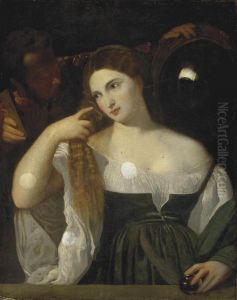Tiziano Aspetti Paintings
Tiziano Aspetti, also known as Tiziano (or Tizianello) di Jacopo Aspetti, was an Italian sculptor of the late Renaissance period, born in 1557 in Padua, then part of the Republic of Venice. Aspetti is often associated with the Mannerist style, which was characterized by elongated figures and an emphasis on artificiality as opposed to the harmonious ideals of the High Renaissance. His work was influenced by his Venetian contemporaries as well as the rich artistic environment of Padua, which was home to the University of Padua, one of Europe's oldest and most prestigious seats of learning.
Aspetti began his career as a sculptor under the tutelage of his uncle, the well-known bronze caster Bartolomeo Campagna. This apprenticeship was crucial in developing his skills in both bronze casting and marble carving. He quickly gained recognition for his remarkable ability to manipulate bronze, a medium known for its difficulty and the high level of mastery it requires.
During his lifetime, Aspetti's works were highly sought after, and he created numerous sculptures for both public and private patrons. His bronze statuettes, often of mythological or allegorical figures, are particularly noted for their dynamic poses and detailed execution. He also worked on larger-scale projects, including public monuments and decorative pieces for churches.
One of Aspetti's most significant commissions was for the Basilica of Saint Anthony in Padua, where he contributed to the bronze reliefs and statues that adorned the altar. His religious works often reflected a deep understanding of human emotion, imbuing his subjects with a sense of piety and devotion that was well received by the Counter-Reformation Church.
Tiziano Aspetti's influence extended beyond his immediate region. He was involved in projects in Venice, where he competed with other great artists of his time, and his works were collected and admired by patrons across Europe. Despite the appreciation he garnered during his lifetime, Aspetti's fame did not endure as strongly as some of his contemporaries, and he became somewhat overshadowed by more prominent figures of the Italian Renaissance in later centuries.
Aspetti died in 1606 in Venice. Today, his sculptures can be found in various museums and collections, serving as testament to his skill and the aesthetic sensibilities of the Mannerist period in Italian art history.
